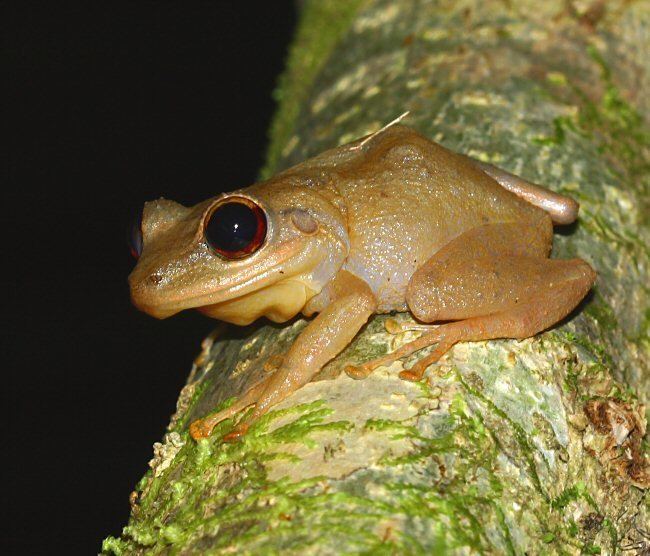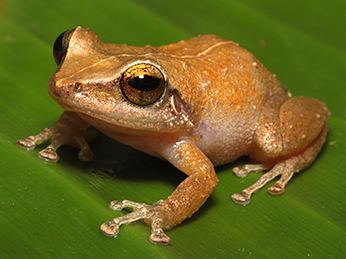Order Anura Rank Species | Phylum Chordata Family Leptodactylidae Subgenus Eleutherodactylus Higher classification Eleutherodactylus | |
 | ||
Similar Eleutherodactylus, Frog, Amphibians, Eleutherodactylus portoricensis, Golden coquí | ||
Coqu com n electherodactyllus coqui common coqu
The common coquí or coquí (Eleutherodactylus coqui) is a frog native to Puerto Rico belonging to the Eleutherodactylidae family. The species is named for the loud call the males make at night. This sound serves two purposes. "CO" serves to repel males and establish territory while the "KEE" serves to attract females. Since the auditory systems of males and females respond preferentially to different notes of the male call, this is an example of a sex difference in a sensory system. The common coquí is a very important aspect of Puerto Rican culture, and it has become an unofficial territorial symbol of Puerto Rico.
Contents
- Coqu com n electherodactyllus coqui common coqu
- common coqui 1 hour
- Taxonomy
- Description
- Native Distribution
- Distribution as an Invasive Species
- Diet
- Reproduction
- References

common coqui 1 hour
Taxonomy

The common coquí was described by R. Thomas in 1966. It belongs to the Eleutherodactylus genus which in Greek means free toes. This genus contains 185 species, which are found in the Southern United States, Central America, South America, and the Caribbean.
Description

Full-grown male coquís measure, from snout to vent, from 30 to 37 mm, with an average of 34 mm, while full-grown females measure from 36 to 52 mm, with an average of 41 mm. The size differences between genders are a result of additional energy consumption related to breeding behavior by males.
Contrary to popular belief and artistic renditions, which depict the species as green, coquís commonly have a gray or gray-brown coloration. Unlike many frogs, coquís do not possess swimming membranes between their digits, and are not adapted to swimming. However, like all tree frogs, they possess small pads on the tips of their toes which help them adhere to moistened or slippery surfaces.
Native Distribution
Common coquís are native to the islands of Puerto Rico, Vieques and Culebra, where they are widespread and abundant; the only notable exception occurs in Puerto Rican dry forests, where the species is rarer. The common coquí is the most abundant frog in Puerto Rico, with densities estimated at 20,000 individuals/ha. Densities fluctuate depending on the season and habitat. Generally, densities are higher during the latter half of the wet season and decrease during the dry season. The species is considered a habitat generalist, occurring in a wide range of habitats, including mesic broadleaf forests, mountains, and urban areas, found in bromeliads, tree holes, and under trunks, rocks or trash. Since the species does not require bodies of water to reproduce, they can be found on most altitudes, provided sufficient moisture is available. In Puerto Rico, they are found from sea level to a maximum of 1,200 m (3,900 ft). Adults generally tend to be found at higher altitudes than juveniles.
Distribution as an Invasive Species
The species has been introduced to the Virgin Islands, the Dominican Republic, Florida, and Hawaii, where it has become a densely populated invasive species. It was accidentally introduced to the Hawaiian Islands in the late 1980s, most likely as a stowaway on potted plants, and quickly established itself on all four major islands. It is now considered a pest species by the State of Hawaii, and is on the list of the world's 100 worst invasive alien species. As an invasive species, it can reach up to 91,000 individuals/ha. Higher densities in its invaded range are likely bolstered by a release from native predators, lack of interspecific competitors, and abundant food availability. In Hawaii, they have been found at a maximum of 1,170 m (3,840 ft) above sea level.
Diet
The common coquí is a general nocturnal predator, which can consume, as a population, 114,000 invertebrates each night per hectare. Diets vary depending on age and size, but are primarily composed of arthropods. Juveniles consume smaller prey, such as ants, while adults consume more varied diets that include spiders, moths, crickets, snails, and small frogs. The frogs are opportunistic sit-and-wait predators, and will forage on any abundant prey items. Males will occasionally consume eggs from their own clutch, likely to provide supplemental nourishment while guarding their nests.
Calling males eat less prey than quiet males, which consume most of their food by midnight, while calling males had eaten only 18% of their food by the same hour.
Reproduction
Common coquís reproduce over the entire year, but breeding activity peaks around the wet season. Females usually lay between 16 and 40 eggs, four to six times each year, at about eight-week intervals. Eggs are guarded from predators—other common coquís and Subulina snails—by the males. The gestation period of coquís is from 17–26 days. The maturation period, the time from egg to reproductive coquí, is around eight months.
Contrary to many frogs, which lay their eggs in water, coquís lay their eggs on palm tree leaves or other terrestrial plants. Abandoned bird nests are also used as nests by E. coqui. The bananaquit, Puerto Rican bullfinch and Puerto Rican tody share nests with the coquí. This method of reproduction allows the coquí to live in forests, mountains and other habitats without direct dependency on water. Since eggs are laid on land, coquís bypass the tadpole stage, proceeding to develop limbs within their eggs, rather than going through a metamorphosis as a larva in water. Thus, a fully independent froglet emerges from the egg, with a small tail that is lost shortly after. This stage of direct development has allowed the coqui to become a successful terrestrial colonizer in tropical areas.
Males begin their mating calls by perching above ground level.
The coqui's call (or canto in Spanish) is used both as a way of attracting a mate and to establish a territorial boundary. A coqui may enter another's territory and challenge the incumbent by starting his call, at which point they may engage in a sort of singing duel (which can last for several minutes). The first to falter in keeping up with the cadence is considered the loser and leaves the area without resorting to physical violence. This behavior is consistent across different species (which have distinctive calls), so it is possible to hear a duel where one coqui sings "COQUI" and another "COQUIRIQUI".
